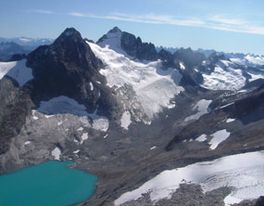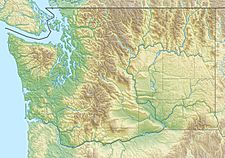Silver Glacier facts for kids
Quick facts for kids Silver Glacier |
|
|---|---|

Silver Glacier lies between the two main peaks of Mount Spickard
|
|
| Type | Cirque glacier |
| Coordinates | 48°58′10″N 121°14′25″W / 48.96944°N 121.24028°W |
| Length | .45 mi (0.72 km) |
| Terminus | Icefall |
| Status | Retreating |
Have you ever seen a giant river of ice? That's what a glacier is! Silver Glacier is one of these amazing ice formations. You can find it in North Cascades National Park in the state of Washington, U.S.. This glacier slowly moves down the side of a tall mountain called Mount Spickard.
Contents
Discovering Silver Glacier
Silver Glacier is a special kind of glacier. It is called a cirque glacier. This means it forms in a bowl-shaped hollow on the side of a mountain. Think of it like a giant armchair carved into the rock by ice!
Where is This Icy Giant?
Silver Glacier is high up in the North Cascades National Park. It sits between two big peaks of Mount Spickard. The glacier starts at about 8,700 feet (2,650 meters) high. It then flows down to about 7,200 feet (2,200 meters).
Below the glacier, about half a mile (0.8 kilometers) away, is Silver Lake. This lake gets its water from the melting ice of the glacier.
Why is Silver Glacier Important?
Glaciers like Silver Glacier are very important for our planet. They store a lot of fresh water. This water slowly melts and feeds rivers and lakes. Many plants and animals depend on this water.
Glaciers also help scientists learn about Earth's climate. They are like giant thermometers. When the climate gets warmer, glaciers often start to shrink.
How Scientists Study Glaciers
The National Park Service is currently studying Silver Glacier. They are part of a project to watch how glaciers are changing. This is called glacier monitoring.
Scientists measure the size of the glacier. They check how much ice it has lost or gained. They also look at how fast it is moving. This helps them understand how climate change is affecting our world.
Silver Glacier is currently retreating. This means it is getting smaller. It is losing more ice than it is gaining each year. Studying this helps us understand the bigger picture of our changing planet.


